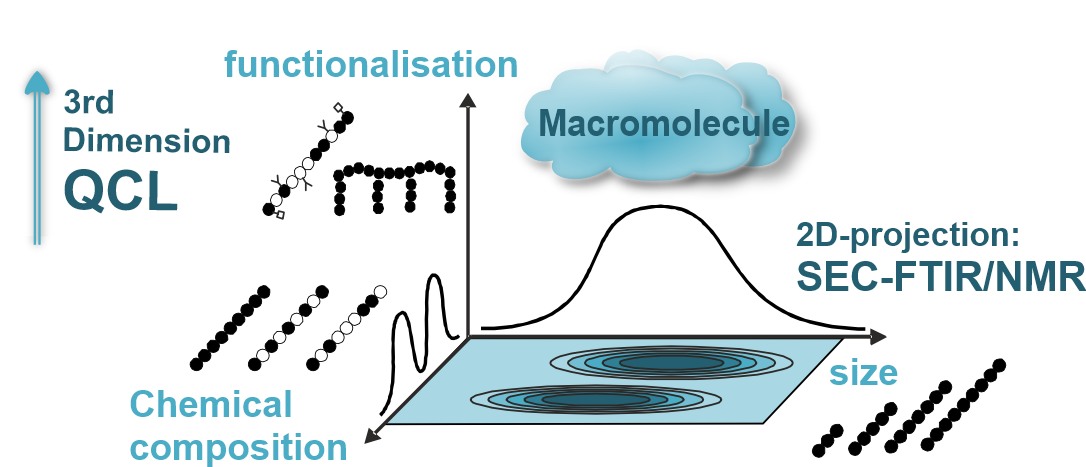Combined characterisation, e.g. hyphenated and correlated methods often allows information not available via separated methods. One Example is shear induced crystallisation in Rheo-NMR, anotherone SEC combined with IR. This already represent the two main fields of this research strand: Combination with rheology and new detectors for chromatograpy, eg. size exclusion chromatography (SEC).
Rheology addresses macroscopic mechanical properties of polymers. However, additional information on the molecular scale is often necessary for a full interpretation of rheological results. Therefore, the simultaneous use of rheology with other methods is highly beneficial. So far, we have coupled small-angle X-ray scattering (SAXS), dielectric spectroscopy and low-field 1H-NMR relaxation spectroscopy with rheology [Ratzsch et al., 2017]. As an actual project, we work on the combination of rheology and IR spectroscopy.
fig.1: 3-dimensional spectroscopy is needed for full characterisation of polymers. Molecular weight distribution, chemical composition and functionalisation (endgroups) are spanning up a 3-dimensional parameter space containing the full information about a polymer. |
| Another focus in this topic is the development of coupled methods based on size exclusion chromatography (SEC) to achieve a simultaneous characterisation of size and chemical information. The main idea is represented in a project of the ongoing SFB1176 and it is an excellent illustration of the strong interaction of our different research strands. As we intend to synthesise precisely defined model polymers, we also need methods allowing to characterise all molecular parameters of a polymer (fig. 1). The first axis, the average size and the size distribution can be exanimated with SEC, the chemical identification and average monomer composition can be clarified with IR-Spectroscopy. The last dimension, special functional groups or end groups, is measured via the assistance of IR-QCL-Lasers (quantum cascade laser). |
This offers the possibility to identify and quantify also rare groups, e.g. end groups or branching points. Only the combination of these three methods in one combined technique offers the possibility of correlated information, e.g. the change in composition or branching degree as a function of molecular weight. FT-IR-SEC is developed to a final state, the combinations with an IR-Laser (QCL) is already working [Morlock et al., 2018]. Actual, we can detect one Carbonyl-Group in a polymer of 500.000 g/mol, but further improvements in sensitivity and especially for accessible functional groups are still necessary.
| Combinations with rheology | New detectors for Chromatography |
|---|
| Already developed methods | |
| Rheo-SAXS (Shear Rheology - Small angle X-ray scattering) |
SEC - FTIR (fourier transform infrared spectroscopy) |
| DMTA-Dielec (Dynamic mechanical analyis - Dielectric spectroscopy) |
SEC - IR-QCL (Quantum-Cascade-Laser IR spectroscopy) |
| Rheo-NMR (Shear Rheology - Low field NMR relaxometry) |
| Developed methods in ongoing improvement | |
| Rheo-Dielec (Shear Rheology - Dielectric spectroscopy) |
SEC - FTIR (fourier transform infrared spectroscopy) |
| Rheo-IR (Shear Rheology - IR-Spectroscopy) |
SEC - NMR NMR spectroscopy combiend with SEC |
| Planned ideas | |
| HPLC- NMR NMR spectroscopy combiend with SEC |
↵
| Please see also the full list of publications | |
|---|---|
| In Situ RheoNMR Correlation of Polymer Segmental Mobility with Mechanical Properties during Hydrogel Synthesis | C. Fengler; J. Keller; K.-F. Ratzsch; M. Wilhelm; Adv Sci 9; e2104231 (2022); DOI 10.1002/advs.202104231 |
| Fourier transformation liquid chromatography: increasing sensitivity by a factor of 50 | M. Matz; C. Botha; T. Beskers; M. Wilhelm; Analyst 147; p 1199-1212 (2022); DOI 10.1039/d1an02298a |
| Rheo-IR: A combined setup for correlating chemical changes via FTIR spectroscopy and rheological properties in a strain-controlled rheometer | N. W. Radebe; C. Fengler; C. O. Klein; R. Figuli; M. Wilhelm; J Rheology 65; p 681–693 (2021); DOI 10.1122/8.0000251 |
| Polymer Crystallization Studied by Hyphenated Rheology Techniques. Rheo‐NMR, Rheo‐SAXS, and Rheo‐Microscopy | V. Räntzsch; M. B. Özen; K.‐F. Ratzsch; E. Stellamanns; M. Sprung; G. Guthausen; M. Wilhelm; Macromol. Mater. Eng. 304, 1800586 (2019); DOI 10.1002/mame.201800586 |
| Online Detection of Functional groups in SEC via Quantum Cascade Laser IR Spectroscopy | S. Morlock, J.M. Kübel, T.F. Beskers, B. Lendl, M. Wilhelm; Macromol. Rapid Commun. 39, 1700307 (2018); DOI: 10.1002/marc.201700307 |
| Low-field rheo-NMR: A novel combination of NMR relaxometry with high end shear rheology | K.F. Ratzsch, Ch. Friedrich, M. Wilhelm; J. Rheol. 61 905-917 (2017); DOI: 10.1122/1.4991513 |
| Linear and nonlinear rheology combined with dielectric spectroscopy of hybrid polymer nanocomposites for semiconductive applications | R. Kádár, M. Abbasi, R. Figuli, M. Rigdahl, M. Wilhelm; Nanomaterials 7 23 (2017); DOI: 10.3390/nano7020023 |
| Combined Dielectric (DEA) and Dynamic Mechanical Thermal Analysis (DMTA) in compression mode | R. Figuli, L. Schwab, J. Lacayo-Pineda, H. Deckmann, M. Wilhelm; Kautsch. Gummi Kunstst. 69 22-27 (2016) |
| Development of a chemically sensitive online SEC detector based on FTIR spectroscopy | T. F. Beskers, T. Hofe, M. Wilhelm; Polym. Chem. 6 128-142 (2015); DOI 10.1039/C4PY01043D |
| In-situ Rheo-Dielectric, ex-situ 2D-SAXS and FT-Rheology investigations of the shear induced alignment of Poly(styrene-b-1,4-isoprene) diblock copolymer melts | T. Meins, N. Dingenouts, J. Kübel, M. Wilhelm; Macromolecules 45 7206-7219 (2012); DOI 10.1021/ma300124b |
| Observation of new states of liquid crystal 8CB under non-linear shear conditions as observed via a novel and unique Rheo/Small Angle X-ray scattering combination | B. Struth, K. Hyun, E. Kats, T. Meins, M. Walther, M. Wilhelm, G. Grübel; Langmuir 27 2880-2887 (2011); DOI 10.1021/la103786w |


